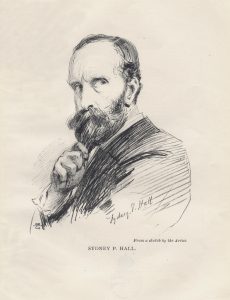Sydney Prior Hall (1842-1922)
The son of a renowned horse painter, Sydney Prior Hall gained a first from Oxford University, but avoided a career in the church having produced a volume of caricatured sketches of the Oxford dons. Instead, he sought employment with the recently formed Graphic shortly after its commencement in 1869. Set up by William Luson Thomas in competition to the Illustrated London News, then the leading publication in the field of pictorial journalism, both the aspirant artist-reporter and the nascent journal established their success with their coverage of the Franco-Prussian War in 1870-71. As Archibald Forbes would later remark, in terms of natural aptitude, it would mark the start of a fortuitous working relationship:
Given a man at its disposition endowed with the gifts to become a great war artist, a young and ardent illustrated journal could wish no better fortune than a great war within six months of its birth.
(‘Famous War Sketchers’, The Sketch, 1 February 1893, p. 31)
Writing a profile of the man who ‘for three-and-twenty year has been my friend and comrade’, Forbes described how they first met in Paris ‘after the victory of Sedan’. For him, Hall was ‘the bringer of unconventionality into the work of the war artist’ (The Sketch, 1 February 1893, p. 31). George Augustus Sala also recalled meeting on the battlefields of Champigny ‘that prince of rapid sketchers, and master of impressionist effects, Mr. Sydney Hall, who held a commission from the Graphic.’ (The Life and Adventures of George Augustus Sala, 1896, p. 535.)

Sydney Prior Hall Self Portrait, engraving, c.1895, NPG D1393
© National Portrait Gallery, London
This lively self-portrait hints at the inherent taste for caricature that continued to manifest itself in Hall’s documentary work. The critic Lewis Lusk noted that ‘the rendering of character in action necessitates a sense of humour, and in Mr. Hall’s sketches appear frequent gleams of that faculty’. His comic frame of mind gave him a talent for ‘diminishing the dryness of an important subject’ that stood him ‘in good stead through all the drawings of the public events which it has been his duty to produce.’ (‘A Famous Journalist’, Art Journal, 1905, p.279)

Sydney Hall in his Cabin. Signed with initials and inscribed partly in Greek
Royal Collection Trust/© Her Majesty Queen Elizabeth II 2016
This comic eye is evident in his sketch of an encounter with a rat on his way to India in 1875, when he travelled as the royal artist within the Prince of Wales’s entourage. Regarded as ‘a prolific contributor to the great journal’, Hall, in later life, was not principally known as a war artist. Although a leading artist-reporter, his career was deemed ‘more interesting than romantic’ and characterised by ‘a history of attendance at Court ceremonies’ (Art Journal, 1905, pp. 278-9). He would be best remembered for his coverage of royal journeys as well as two parliamentary cause célèbre, the Parnell Commission and the Jameson Raid Enquiry. Privately educated, he operated with ease amongst privileged circles, leading one member of the Prince’s Indian entourage to include the line in his acrostic verse: ‘H is for Sydney Hall, an artist of merit, a gentleman, painter and friend all combined’ (My Memories 1830-1913 By Lord Suffield, 1913, p. 258).